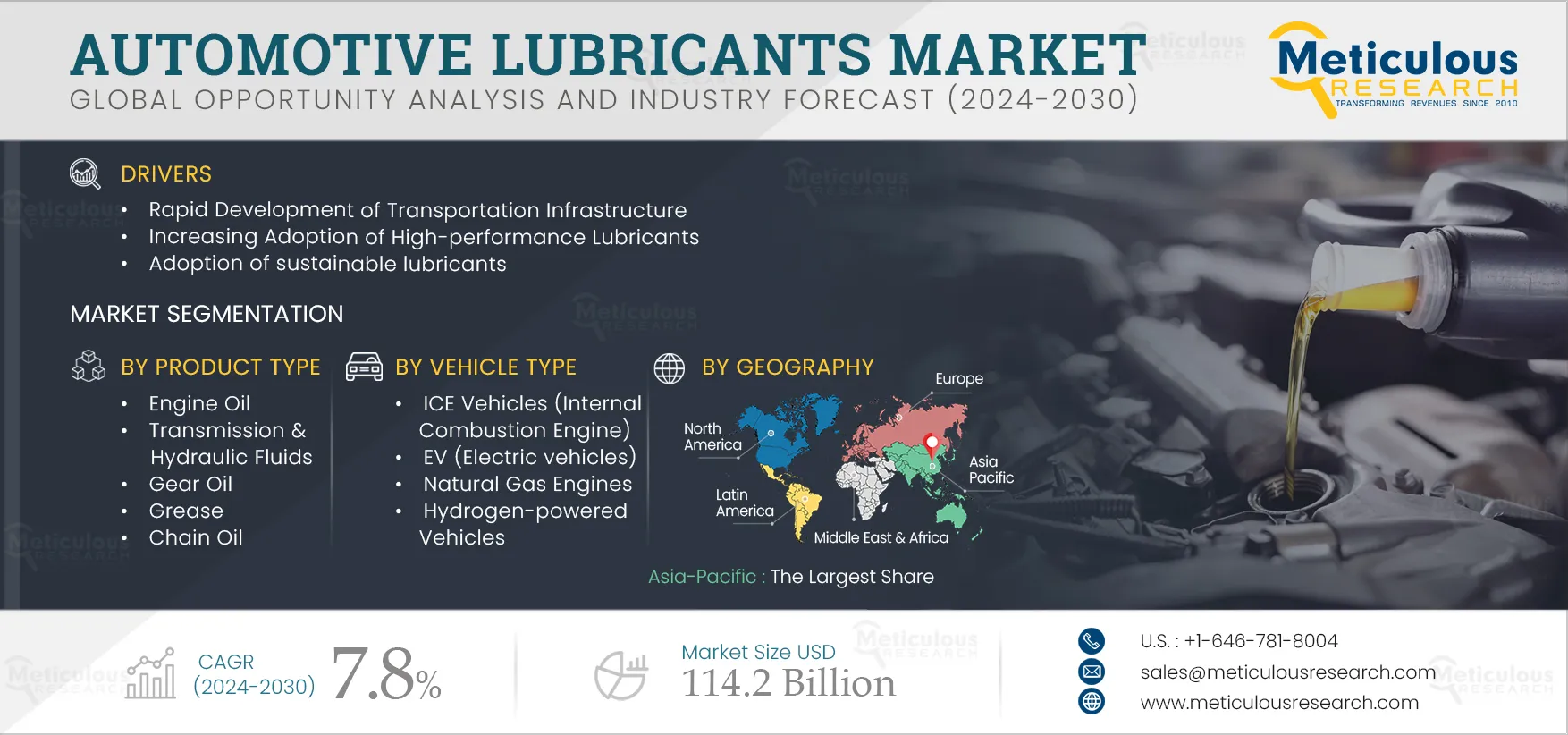The Automotive Lubricants Market is expected to grow at a CAGR of 7.8% from 2024 to reach $114.2 billion by 2030. Automotive lubricants are used to reduce friction between the surfaces and contact such as road and vehicle, which protects the automotive parts and hence, increase the vehicle performance. The growth in this market is majorly driven by the growing automotive industry, increasing production of vehicles, and rise in disposable income. Further, significant opportunities from emerging economies and increasing demand for environment friendly lubricants are boosting the adoption of automotive lubricants.
Here are the top 10 companies operating in the Automotive Lubricants Market
Shell International B.V. (the Netherlands)
Founded in 1907 and headquartered at the Hague, the Netherlands. Shell International B.V. is an international energy company operating in exploration, production, refining, and marketing of oil and natural gas, and the manufacturing and marketing of chemicals. Shell International B.V. is a subsidiary of the Royal Dutch Shell plc whose operations are divided into upstream, integrated gas and new energies, and downstream segments.
The company has its geographic presence across North America, Asia-Pacific, Oceania, Europe, Latin America, and Africa.
China National Petroleum Corporation (China)
Founded in 1988 and headquartered at Beijing, China. China National Petroleum Corporation (CNPC) operates as an oil and gas company. The company’s line of business includes oil and gas operations, oilfield services, and petroleum equipment. It is one of the world’s major oilfield service providers and a globally reputed contractor in engineering construction, with businesses covering petroleum exploration & production, natural gas & pipelines, refining & marketing, oilfield services, engineering construction, petroleum equipment manufacturing, and new energy development, as well as capital management, finance, and insurance services.
The company has its geographic presence across Central Asia-Russia, Americas, Asia-Pacific, Latin America, and the Middle East and Africa.
Chevron Corporation (U.S.)
Founded in 1879 and headquartered at California, the U.S.; Chevron Corporation is engaged in the integrated energy and chemicals operations. The company produces and transports crude oil and natural gas. Chevron also refines, markets, and distributes fuels, as well as is involved in chemical and mining operations, power generation, and energy services. The company offers fuels, motor oil, fuel additives, base oils, chemicals, natural gas, lubricants, and other related services. The company operates through two segments, namely upstream and downstream.
The company has its geographic presence across North America, Europe, Asia-Pacific, Latin America, and the Middle East and Africa.
Exxon Mobil Corporation (U.S.)
Founded in 1999 headquartered at Texas, the U.S.; Exxon Mobil Corporation operates as publicly traded international oil and gas company. The company operates into three business segments namely upstream, chemical, and downstream. The company has its geographic presence across North America, Asia-Pacific, Oceania, Europe, Latin America, and the Middle East and Africa.
Phillips 66 Company (U.S.)
Founded in 1917 and headquartered at Texas, the U.S.; Phillips 66 Company operates as an energy manufacturing and logistics company. The company’s operations include oil refining, marketing, and transportation. Phillips 66’s operations also include chemical manufacturing and power generation. The company operates through four segments, namely refining, midstream, marketing, and chemical.
The company has its geographic presence across North America, Europe, and rest of the world.
FUCHS PETROLUB SE (Germany)
Founded in 1931 and headquartered at Mannheim, Germany. FUCHS PETROLUB SE is engaged in the manufacturing of lubricants and related specialty products. The company refines and produces industrial and automotive lubricants. The company also produces biodegradable oils. The FUCHS product program comprises of more than 10,000 products and related services in six key categories: automotive lubricants, industrial lubricants, lubricating greases, metal processing lubricants, special application lubricants, and services.
The company has its geographic presence across North America, Latin America, Europe, Asia-Pacific, and the Middle East and Africa.
Klüber Lubrication München SE & Co. KG (Germany)
Founded in 1929 and headquartered at München, Germany. Klüber Lubrication München SE & Co. KG develops, manufactures, and supplies specialty lubricants. Klüber Lubrication supplies products and services to most of the industries including, automotive, railways, glass manufacture and processing, rubber and plastics, wood, pulp and paper, food and pharmaceuticals, marine, metalworking and processing, mining, oil & gas, steel, textile, corrugated cardboard production, wind power industry, and cement. The company offers speciality lubricants, tribological solutions, lubrication, hydro lubricants, PFPE, lubricant sprays, oils, greases, pastes, NSF H1, lubricant dispenser, tribometry, lubricating greases, lubricating oils, lubricants, and MOSH MOAH.
The company has its geographic presence across North America, South America, Europe, Asia-Pacific, and the Middle East and Africa.
Petróleo Brasileiro S.A. (Brazil)
Founded in 1953 and headquartered at Rio de Janeiro, Brazil. Petróleo Brasileiro S.A. is engaged in the exploration and production of oil and natural gas. The company operates through five segments, namely refining, transportation & marketing, exploration and production, distribution, gas & power, and biofuels.
The company has its geographic presence across South America, North America, Africa, Europe, and Asia.
BP P.L.C. (U.K.)
Founded in 1908 and headquartered at London, the U.K.; BP P.L.C. (CASTROL) operates as a manufacturer of refined petroleum products and supplier of fuels and retail services. The company operates through three business segments, namely upstream, downstream, and rosneft.
The company has its geographic presence across Europe, America, Asia-Pacific, the Middle East & Africa, and Latin America
Valvoline, Inc. (U.S.)
Founded in 1866 and headquartered at Kentucky, the U.S.; Valvoline, Inc. manufactures and distributes automotive lubricants and chemicals. The company offers engine oils, lubricants, automotive maintenance, engine maintenance, motor oil, and consumer packaged goods.
Valvoline has a strong international presence with products sold in more than 140 countries. In the U.S., and Canada, Valvoline’s products and services are sold to retailers with over 30,000 retail outlets.
Popular Mentions – Motul (France), Repsol S.A. (Spain), SK lubricants Co., Ltd. (South Korea), Amsoil Inc. (U.S.), and JXTG Nippon Oil & Energy Corporation (Japan).
























